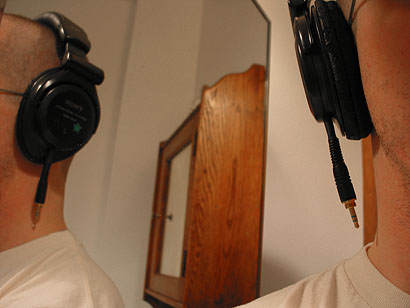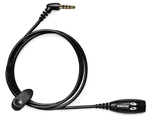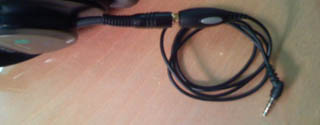
I bought Peggy a new pair of studio monitor headphones for her birthday last week. So now we have an extra pair of my favorite headphones, the Sony MDR-V600. I decided to try an experiment I’ve always wanted to do: To separate a pair of headphones from its cord.
My practical objective was in part driven by the onset of winter’s cold: I wanted to figure out a way to use full sized over-the-ear headphones with my iPhone, without losing the ability to use the iPhone’s wonderful on-cord control doohickey (which allows you to pause, play, or skip tracks, as well as being a hands-free microphone and call controller).
So I opened up the headphones, cut the cord down to only a few inches, and soldered the shortened cord to the contacts inside the headphones themselves. I closed everything up, and the result can be seen above.

Now, what about the iPhone’s clever controller cord?
Shure makes a nifty little doodad that does exactly this: it has all the functions of the iPhone doohickey, but instead of having any headphones of its own it allows you to plug your own headphones into the female socket on the end of it. Many users of the Shure cord complain about all the excess cordage that results from using this with a full set of headphones. But I think with these no-cord headphones I’ve managed to completely avoid that problem. I’ve just now ordered the Shures from the Apple Store, and I look forward to plugging these two things together and rocking out in the cold weather.

This idea, in fact, has been bouncing around in my head for several years, long before the iPhone. I’ve long thought that headphones, especially high-end headphones, should come in two peices: (a) the part that goes on/over/in your ears, and (b) the cord. Headphone cords could then come in a variety of lengths, colors, and features. So you could choose a 10-foot long phone-like coiled cord for use as you dance around to your latest track in your home music studio, or you could choose a compact lil’ 2-foot cord for when you are keeping your iPod nano in your breast pocket.
In my original conception, the headphones would have no male plug on them at all. They would merely have a female socket, while the cords would be male-to-male. But since female-to-male headphone extension cords, like the Shure model, are a more common (and more useful) accessory, I opted for the female-to-male approach for the headphone cord.
Finally, I just realized that I can also simply plug an iPod shuffle directly into the headphones and go completely cordless, rocking out with a single dangling iPod earring.

UPDATE: Well, the Shure cord arrived yesterday, and the whole setup works great. The cord is short — just long enough to reach my pants pocket. It is not an inch longer than it needs to be. The sound quality is fine, the industrial design is solid. Success!
Comments
11 responses to “The 1/2-inch Headphone Cord (iPhone Ready!)”
Not a bad idea, but the high-end headphone makers won’t buy it. Sticking another connection in the chain just… because? That’s another chance for the signal to degrade and cancel out the whole reason you bought the fancy-schmancy cans to begin with.
@Mer: Good point. There are certainly audiophiles who care very deeply about the kind of sound quality degradation that can occur between jacks. Especially those who buy the highest-end headphones. But the audience for $50-100 cans, which still counts as high end IMHO, is a slightly different breed. These folks care about sound quality but not nearly to the same degree that audiophile geeks do.
When people shop for headphones, it’s often the industrial design alone that makes the difference between one model and another — not the sound quality. They also look for comfort, style, durability, versatility, and portability.
This difference is especially stark when the intention is to use them portably. Almost every complaint I’ve ever heard about portable headphones has been about the industrial design, not the sound: the fit most of all (anecdotally, it seems like about a third of all iPod/iPhone owners simply cannot use the included Apple earbuds because they fall out of their ears, and they have to go out and buy their own), but also the cord, the jack, the remote control. Some people get custom fit earbuds or, like me, have a favorite over-the-ear model. This is for them.
Actually, Mer, this is more or less what Bose did with their high-end noise-cancelling headphones.
The earpiece has but a female connector, and while the case includes a male-male gold-tipped wire of just the right length, they’ve also anticipated the common use case that involves no signal input whatsoever. It’s nice. My only complaint is that the Bose headphones look so execu-cheesy…they could use some Ive-isizing, for sure.
Chris is spot on as to the primacy of industrial design in determining consumer choice in this space. You could argue that the Bose cans, impressive as they are, can’t hold a candle to the sound quality of other alternatives. But they fit well, I can wear them comfortably for the length of a trans-Pacific flight, and that’s the relevant boundary constraint.
W/r/t the earbuds that come with the iPhone, my own issue runs in the opposite direction – my earholes are too small! And boy does it piss me off that I had to buy a cheap Belkin adaptor to use my UE10s with my phone.
Then again, I barely use the iPod functionality on the phone. I’m a scroll-through-the-pocket kind of guy, and I’ll be gutted when they transition the entire line to multitouch UIs.
I do love the idea of being able to unplug it at the top of the cord. …and the fact that it would come free when I trip on the cord, as I often do.
I doubt a Shuffle could power those phones, though.
nothing quite like the WWII Telegraph Operator look …
Brilliant. I’d been thinking of ways to use quality headphones with an iPhone, and this is a great idea with that Sure mic.
Nice article,
I have a set of the Bose over the ear headphones (couldn’t justify the extra for the the noise cancelling ones) and they have exactly what you’ve discussed. A female socket on the headphones and they supply both a long (approx 2M) and a short (approx 30cm) cord in the included hard case.
I have found the sound quality on these superb. Ok, they’re biased for listening pleasure rather than being flat as studio monitors should be but the provide a very nice tone and I have noticed so many more intricate subtleties on tracks that I never knew existed.
Oh and they’re also really comfortable! I can wear these all day with no discomfort, although if you are a glasses wearer, like I am, you may want to move the arms of your glasses above the ear pieces as the headband is slightly sprung and will push your ears into the arms of your glasses after a while.
Do I work for Bose? No! Would I recommend these? Definately!
I am really interested in buying this exact pair of headphones, as I am in that specific category of consumers that is looking for a high-end set of over-the-ear headphones for less than $150. I haven’t visited any stores to try them yet, but I would be content with buying them online if someone could settle this one question of mine…
I read that the coiled cord is ten feet long. Is this while its completely extended? In any case, will it get in the way of extensive walking/traveling, because as an active college student I plan on walking between 3 to 5 miles a day with these on. Thanks for any tidbits of experience and advice.
I know this is an old post, but thought I would add a point:
Really good AKG headphones (like the K271 or the K240) come with a removable cord (mini-XLR -> 1/8″)
I think I might try this method to mod-together a version of this Shure that has a mini-XLR end.
Blackbox cans already have female ports instead of attached cords: http://www.blackboxonline.com/
It’s really quite awesome.
@will Those Blackbox cans are nice… I like how they fold flat, too. Now I’m thinking that in order to enjoy my new setup with the Shure cords I’m going to need a one-inch male-to-male cord/dongle. Oh, and it looks like Blackboxes are only available in New Zealand — can that be true?